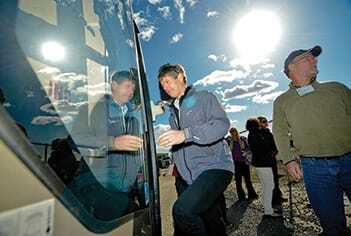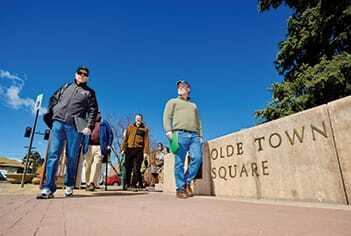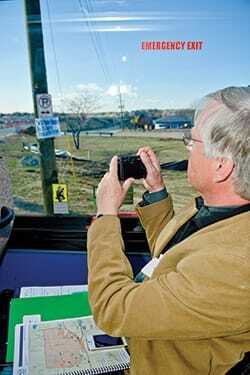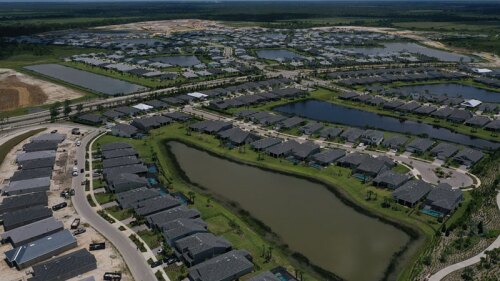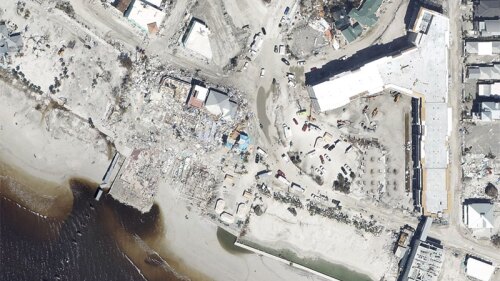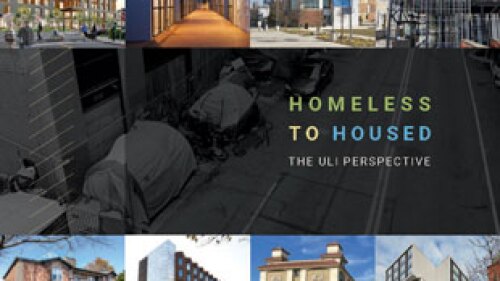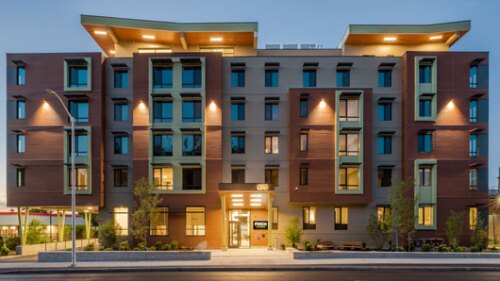An important transit-oriented development is on the way. Will the right mix of sidewalks, bike paths, and parking policies allow the project to leverage its benefits?
On a sunny but bone-chilling windy day in late March, with the Rocky Mountain foothills flanking their views to the west, seven members of a ULI Advisory Services panel listened to the whistle of a freight train as it made its way slowly through the heart of Olde Town Arvada, Colorado, about seven miles (11.3 km) northwest of Denver. Their task: envisioning how changes to the physical environment could improve the health of Arvada residents.Their visit was part of a new Colorado Health Foundation (CHF) initiative, Healthy Places: Designing an Active Colorado. Communities that complete the panel process have the opportunity to apply for up to $1 million each from the CHF to implement their plans. The CHF’s goal is to make the “healthy choice the easy choice” for the communities and to seek recommendations on how communities can ensure that their infrastructure is conducive to physical activity and healthy eating in order to reduce obesity in Colorado.
Arvada was the first of three areas in the state targeted by the CHF, a $2.2 billion foundation that gives away $100 million annually. Twenty-six Colorado communities applied for CHF grants to sponsor ULI panels.
Related Content: Health in the City: Denver’s Westwood
Related Content: Health in Rural Areas: Lamar, Colorado
Arvada traces its roots to 1850, when prospectors found the first gold in Colorado. The city comprises 23,000 acres (9,300 ha)—about 1.5 times the size of the island of Manhattan, although it has a population of just 108,000, compared with more than 1.6 million in Manhattan. Arvada boasts more than 140 parks and 125 miles (200 km) of trails, which connect to numerous other trails that provide a network of biking and running paths.
The ULI panel focused on southeast Arvada, where 22,000 people live. It is an area whose main artery is Wadsworth Boulevard, the busiest road in Arvada, and to the south it is anchored by big-box retailers including Costco, Home Depot, and Lowes. One ULI panelist noted that crossing Wadsworth as a pedestrian was “slightly terrifying.”
The ULI contingent envisioned what a large plaza in the Olde Town section of Arvada will look like two years from now, when a key transit-oriented development (TOD) is expected to open along the Gold Line, an 11.2-mile (18 km) commuter-rail line scheduled to open in 2016.
In addition to chair Ed McMahon, ULI senior resident fellow, the panel consisted of Richard Albrecht, principal of Lattice Properties in Park City, Utah; Suzanne Nienaber, partnership director for the Center for Active Design in New York City; Klaus Philipsen, an architect who is president of ArchPlan in Baltimore; Bob Taunton, principal of the Taunton Group in Boise, Idaho; Ross Tilghman, director of the Tilghman Group in Seattle; Waverly Wood, coordinator of the Center for Design & Health at the University of Virginia in Charlottesville, Virginia; and Tamara Zahn, president of Zahn Associates in Indianapolis. Collectively, the seven panel members—who donated their time and expertise—brought more than 155 years of experience to the table in a wide range of disciplines, including architecture, planning, land use, and health care.
Although none of the panelists was from Colorado, they so engrossed themselves in phone book–thick data packages on the city that by the end of the week they could speak about Arvada as if they were residents themselves. They took notes and photographed broken, disconnected sidewalks during a bus tour of post–World War II neighborhoods in the first-tier city west of Denver. They interviewed dozens of stakeholders, ranging from longtime residents to urban planners to politicians.
On March 22, the panel members presented their wide-ranging recommendations at a public meeting attended by about 50 people. Their recommendations included ways to encourage walking and biking, making parks more attractive and interactive, painting asphalt playgrounds, repairing broken sidewalks, improving connections to trails, seeking grants for neighborhoods, pinpointing areas for grocery stores, incorporating health-driven concepts into new developments, and incentivizing owners to provide health-driven features in existing developments.
“They exceeded my expectations,” said Anne Warhover, president and chief executive officer of the CHF. Warhover said she liked that the ULI panel was composed entirely of outsiders, who can look at the area with fresh eyes, yet have no financial incentive that could influence their recommendations.
“If you can keep going back to the same [medical and health] sources, they tend to give you the same answers. I really wanted people who would think outside of the box, and that is what we got with the ULI.” Warhover said she thinks ULI’s findings can and should serve as a national model for addressing health issues in communities. “This is the new green,” Warhover said. “A number of years ago, it was a novel idea to construct buildings in a green and sustainable fashion. Now, it is expected. The same thing is going to happen with health concerns. Our physical environment does impact things like obesity. A time is coming when it will be standard practice to incorporate health measures into development. This is the start of something big.”
Brad Segal, head of Denver-based Progressive Urban Management Associates, who has been hired to track progress and help implement recommendations from the ULI panel in the three communities over the next three years, agreed.
“First, this is pretty cool,” Segal said. “I really think this is going to put Arvada on the map. Once these recommendations start becoming reality, I think we will become a national and even an international model, and it is going to happen faster than you would think. I believe we are going to serve as a model for other communities right out of the gate.”
Panelist Wood said lessons from the 19th and 20th centuries in the United States can provide a road map for creating a healthier Arvada. She noted that chronic diseases in the United States such as tuberculosis, cholera, and yellow fever were treated not only with medicine, but also with provision of clean drinking water, visits to parks for exercise and fresh air, and use of rail lines, which helped relieve overcrowded urban areas. Today, she said, obesity is a $147 billion-per-year problem in the United States.
Part of the problem is that it is easier for people to dine on fast food than on healthy food. Arvada could use more neighborhood grocery stores, Wood said. She showed a map of Arvada portraying “food deserts"—large swaths of land where a grocery store is not within a one-mile (1.6 km) walk or a ten-mile (16 km) automobile ride. The already popular Arvada Farmers Market should be expanded, said panelist Nienaber.
The city wants to encourage more people to walk and bike, and those are goals that Arvada needs to build on, said Nienaber. Arvada, for example, is looking to promote walking by repairing and expanding the city’s sidewalk network to better connect to parks and trails. Nienaber said a back-of-the-envelope calculation estimated that a “missing sidewalk project” could be completed in five years for $5 million.
Parks need to be well lit, safe, and appealing, she noted. What has proved effective in New York City is to use paint to jazz up asphalt playgrounds, Nienaber said, displaying a playground in an Arvada school and comparing it to a much more visually appealing one in New York.
Car traffic, Nienaber said, needs to be “calmed” on certain busy streets so that children or parents pushing a baby carriage can feel they can cross the road without danger of being run down. “Arvada should conduct a needs assessment at those key intersections,” she said.
To encourage pedaling, she said bicycle parking needs to be greatly expanded, both indoors and outdoors.
Nienaber said she was impressed by the beautiful parks in Arvada, but said more needs to be done to make them inviting to children, parents, and senior citizens. For example, the city might provide exercise stations for adults, so while their kids play, the parents could also get a workout, she suggested. The parks also need to be better lighted so that people will feel safe visiting them in the evening, Nienaber said.
Panel member Albrecht, who previously developed resorts in Hawaii, suggested grassroots programs to “turn the tide of behavior now,” to reduce obesity. It is especially important to change the culture of at-risk groups who are suffering from a higher statistical rate of obesity, such as the poor and minority groups, he said.
Albrecht applauded existing outreach efforts to citizens, such as the Arvada TRYathlon, which encourages everything from ice skating to rock climbing to pickleball (a fast-growing racquet sport) to Zumba at the Apex recreation center in Arvada. “That is a great program to get people to engage with neighbors,” he said.
Albrecht suggested that the city support a neighborhood-level action plan to identify exercise programs that can easily be integrated into the city.
To bring more energy into Olde Town Arvada—an enclave with an eclectic mix of historic and newer buildings—events could be held there. “It doesn’t have to be something like a marathon or 100-mile bike ride,” Albrecht said, because people involved in those types of events are already getting exercise.
Panelist Taunton suggested that interfaith groups, service clubs, and area businesses be tapped to promote healthy habits for citizens. He said a community coordinator from the city could work with these groups and identify resources.
The city of Boise, he noted, challenged residents to walk at least 150 miles (242 km) in a year to celebrate the city’s 150th birthday in July.
Another idea, Taunton said, is to have a “walking school bus,” whereby parents walk to school with their young children, instead of having them take the bus or driving them.
“Whatever you do, don’t be afraid to fail,” he said. “Look at this as an R&D exercise program. We do have a sense of urgency, because we have a very significant obesity problem and we need to invest in programs now.”
Panel member Philipsen said the city needs to set high standards for developments, such as public/private TOD sites around Arvada’s coming rail stations. He added that development must be addressed as a whole, and not in a piecemeal fashion or in phases. For example, Philipsen noted that a luxury apartment community has been built near the upcoming Arvada Ridge rail station. However, he said the layout of the community does not maximize the “larger vision for a transit village.” Details, such as making sure that renters would be encouraged to walk to the nearby rail station, should be part of the development process, he added.
Also, Philipsen said the layout of the planned Walmart should be changed to put the surface parking in the back and the entrance close to sidewalks. Otherwise, he said, the city is just exchanging the square footage of the strip center storefronts for a Walmart.
One thing Philipsen and Tilghman pointed out is that having parking lots at the Gold Line train station is not conducive to increasing pedestrian traffic to the eclectic mix of businesses and buildings in Olde Town. Most commuters arrive early before stores open; and if they buy anything, it is likely to be a cup of coffee.
The city plans to make a large investment in structured parking by the Gold Line station, but those spaces will be available for nontransit use only in the evening, they noted.
One suggestion they made was to keep the surface parking, with the idea that the land would be redeveloped later for a more productive use. “A major park-and-ride is inconsistent with the goals of the city,” Tilghman said.
Arvada Mayor Marc Williams said, “Arvada was thrilled to host ULI and its panel.” He said the panel came up with so many recommendations that it is a lot to digest. “But I guarantee you, this is not going to be a study that is going to sit on a shelf and gather dust.”
The Building Healthy Places Initiative leverages the power of ULI’s global networks to shape projects and places in ways that improve the health of people and communities. Learn more.

